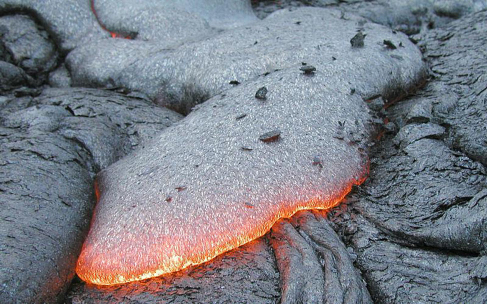| << Chapter < Page | Chapter >> Page > |
By the end of this section, you will be able to:
Let us now examine our planet’s outer layers in more detail. Earth ’s crust is a dynamic place. Volcanic eruptions, erosion, and large-scale movements of the continents rework the surface of our planet constantly. Geologically, ours is the most active planet. Many of the geological processes described in this section have taken place on other planets as well, but usually in their distant pasts. Some of the moons of the giant planets also have impressive activity levels. For example, Jupiter’s moon Io has a remarkable number of active volcanoes.
Earth’s crust is largely made up of oceanic basalt and continental granite. These are both igneous rock , the term used for any rock that has cooled from a molten state. All volcanically produced rock is igneous ( [link] ).

Two other kinds of rock are familiar to us on Earth, although it turns out that neither is common on other planets. Sedimentary rocks are made of fragments of igneous rock or the shells of living organisms deposited by wind or water and cemented together without melting. On Earth, these rocks include the common sandstones, shales, and limestones. Metamorphic rocks are produced when high temperature or pressure alters igneous or sedimentary rock physically or chemically (the word metamorphic means “changed in form”). Metamorphic rocks are produced on Earth because geological activity carries surface rocks down to considerable depths and then brings them back up to the surface. Without such activity, these changed rocks would not exist at the surface.
There is a fourth very important category of rock that can tell us much about the early history of the planetary system: primitive rock , which has largely escaped chemical modification by heating. Primitive rock represents the original material out of which the planetary system was made. No primitive material is left on Earth because the entire planet was heated early in its history. To find primitive rock, we must look to smaller objects such as comets, asteroids, and small planetary moons. We can sometimes see primitive rock in samples that fall to Earth from these smaller objects.
A block of quartzite on Earth is composed of materials that have gone through all four of these states. Beginning as primitive material before Earth was born, it was heated in the early Earth to form igneous rock, transformed chemically and redeposited (perhaps many times) to form sedimentary rock, and finally changed several kilometers below Earth’s surface into the hard, white metamorphic stone we see today.

Notification Switch
Would you like to follow the 'Astronomy' conversation and receive update notifications?